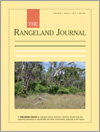RJ17025Seed ecology of Captain Cook tree [Cascabela thevetia (L.) Lippold] – germination and longevity
Cascabela thevetia (Captain Cook tree; yellow oleander) has become an invasive weed in northern Australia. Seven experiments related to seed germination and longevity of its yellow and peach biotypes were undertaken. Both biotypes germinated across a wide range of temperature regimes and under both natural light and shade conditions. With seeds appearing to remain viable for only 2 years in the field, this weed is manageable provided annual control activities are undertaken to help prevent replenishment of soil seed banks.




